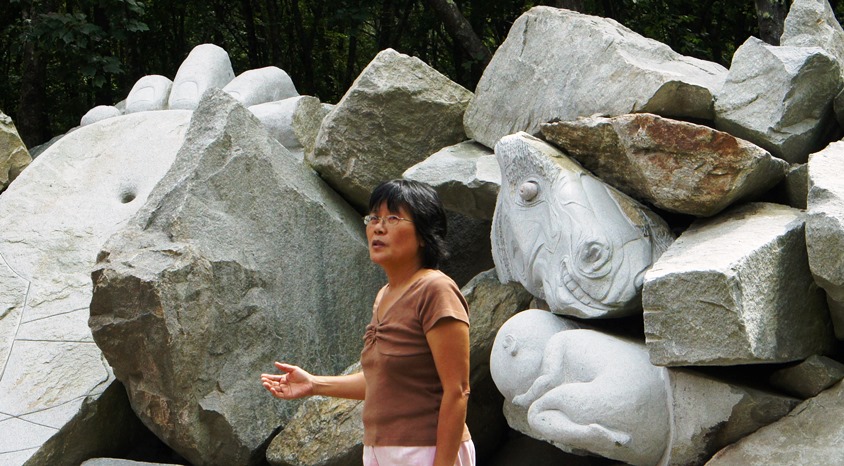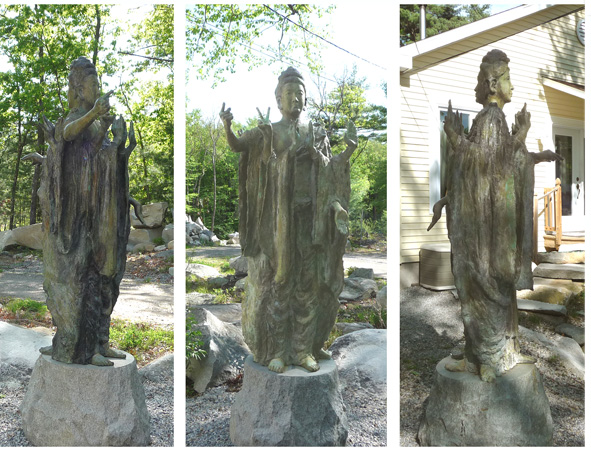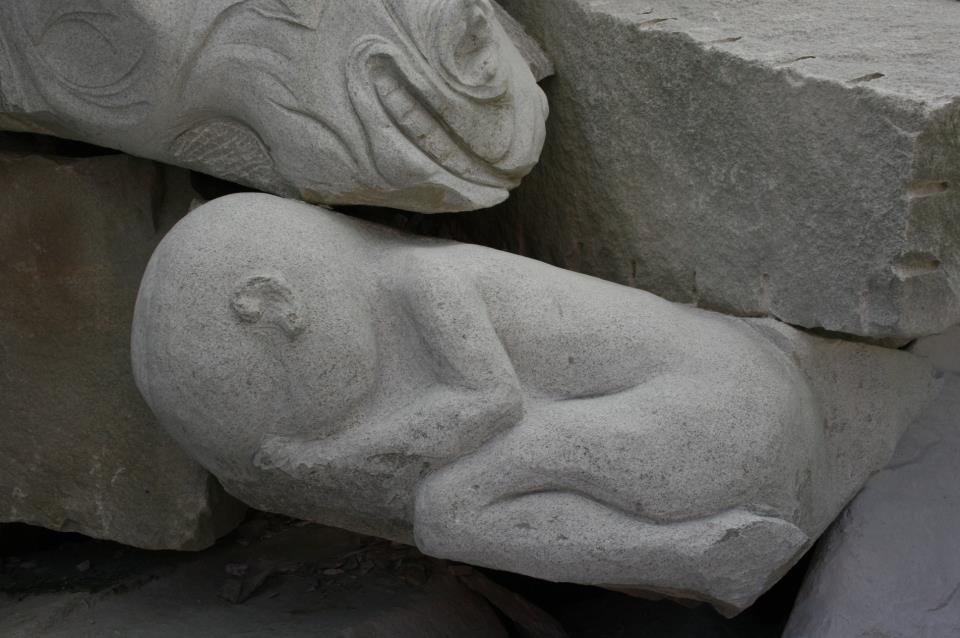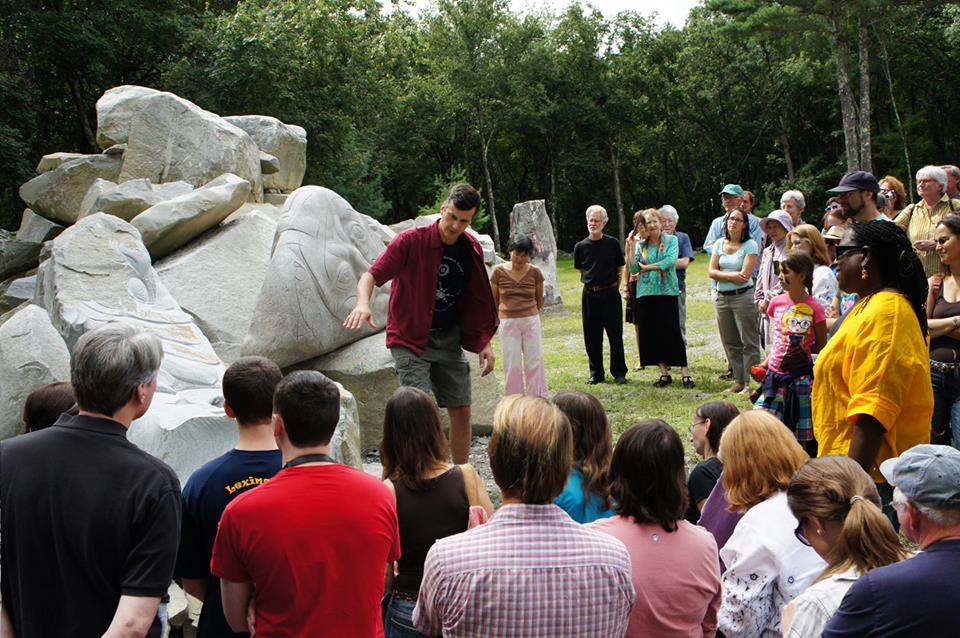By Ismary Munet
Born in Taiwan, and in 1982 landed in Connecticut, Yin Peet has influenced the world of art and sculpture with her Asian background and Buddhist philosophical ideas. Peet eventually founded Contemporary Arts International, of which she is also director of, which provides artists “with resources to develop and realize ambitious projects and ideas.” She has an MFA in sculpture from the Massachusetts College of Art, and is also currently an adjunct faculty member at the College of the Holy Cross. Peet’s work has been shown throughout the U.S., Asia, and Europe, and has won many awards for her unique work. She shares her story of once being conscious about being different, but later embracing it and using it in her work. Peet stresses the importance of individuals coming together, communicating and interacting with one another, to not only make each other better, but the world and art better by allowing an exchange of ideas, thoughts, and criticisms to take place.
Q: Tell me about yourself, your background. What is your childhood story? When did you know you wanted to become a sculptor?
Peet: I came to the U.S. in 1982 from Taiwan, landed in Wilton, Connecticut. It’s a very white community, reminiscent of what I saw on TV in Taiwan growing up. I don’t recall much culture shock. Nevertheless, I was conscious about my being different.
The seed to be an artist in me was planted when I was in high school. Much to my perplexity, my art teacher, whenever an opportunity arose, would send me to painting competitions. I never won anything, but she continued sending me to the “front line,” and often pinned my artwork up on the school bulletin board. Though she never analyzed for me what was good about what I did, her persistent encouragement planted the seed. Maybe I could go into art. Back in 1975, the National Exam guarded the gate to University enrollment, and I ended up in the English Literature Department.
The summer before I entered college, my brother-in-law taught me Chinese Seal Carving in stone and “Nu” (the mini-sculpture on top of the Seal), and without much instruction, I found I could carve 3D images seemingly effortless, and I happily took that skill with me to college in Taipei, and self-explored this art form for the following 4 years. My desire to pursue art hid secretly in my heart. The seed finally germinated when I came to the U.S. in 1982, and got a chance to study at the National Academy of Design in New York City. I was an “impatient” student; I would whip one figure out in a week or two, and I couldn’t wait to capture other model’s poses. I was absorbing knowledge in sculpting like a thirsty sponge searches for water.
Q: How does being Asian American influence your work?
Peet: From 1984 to 1988, I traveled and lived in Nepal to accompany my husband and gave birth to two children. For four and a half years, I was immersed in South Asian culture, learned to speak Nepali, raised a family with two children and painted almost every day (and later sculpted and learned bronze casting using a primitive method.). Back in 1982, the U.S. did not give me culture shock, but in 1984 South Asia did. Its way of life, its social structure, its smells, colors, all suggested that my earlier assumptions about judging things appropriate or inappropriate, good or bad, could no longer hold up. Like most of the newcomers, during the previous two years in the U.S., I constantly compared things, calculating higher/lower values (including currencies), but there were just two to compare, Taiwan and U.S. Now, with Nepal in the picture, there are two plus an “other.” My life became much more complex, my way of thinking was no longer black and white; I began seeing that everything is in the grey zone.
When I came back to the U.S. in 1988, we settled in the Boston area. I entered Mass Art, got my MFA in 1991, and people began to call me an artist! Yes, I believe that one does not name oneself an artist; it is others who name you “Artist”—an East Asian traditional understanding.
Because my parents, brothers and sister are in Taiwan, I go back to visit every year. Taiwan’s modernization is moving forward with tremendous speed. Friends remind me that I speak with 1982 Taiwanese expressions, judge with 1982 cultural/aesthetic values, search for roads in the 1982 map in my head… But I knew I could also count on one thing, a shelter where my feelings could nestle, a foundation where my life philosophy could be understood and my sense of aesthetics could stand, and that is the Art. How strange, this realization only occurred to me when I returned to the U.S.
This realization prompted me to express in Art the “foundation” in me. At first, I sculpted figurative images with dual or triple images on the same body, such as the “Our Goddess” (1993), one side a Greek Goddess, the other side a Guan Yin Buddha, 12 arms, each with modern gestures that have dual meanings depending on the viewers’ cultural interpretation. Soon, I recognized that some concepts are beyond what a still object can fully articulate, for example, the concept of “Yuan”—Karma, Chance. There are certainly enough Western artists like John Cage and Jackson Pollock who have explored and brought great results that have impacted Western society. I asked myself: what would one who holds East Asian inheritance like me explain the concept of “Yuan,” such an important word in the Buddhist Asia asserts how the Universe/world/we got started and going. Clearly the 3D object doesn’t seem complete; it requires Time, Action, Interaction and Sound… and my piece “Yuan” was presented in 1996 as the following: (space 500’x500’ with audience seats ¾ circle, multi-layer, about 150 people) Performer Uchida (U) enters the center with a big bundle/coil of steel wire (1/16”) placed in the center stage. Performer Peet (P) rolls an egg shaped structure (welded with 3 bended 1/8” steel rods) onto the center stage, with one swing, and encages U whose hands hold a wood chanting block. There are nine wood blocks in the audience area. P starts by picking up one end of the steel coil, walking and wrapping the egg shaped structure. At each steel wire meeting point, she ties a white cable tie. When she ties the first point, U strikes the block once to announce the action done, the 9 audience members with blocks follow and strike once; when she ties the second point, U strikes the block once again, the audience members strike twice. For the third point, U strikes again, and the audience members strike three times…. By the seventh tie, the audience members’ wood blocks sound continuously and steadily… P keeps walking and tying for about 30 minutes. When the white Egg comes into formation, P then picks up the other end of the steel coil, wrapping herself walking in the opposite direction until she is stopped by the Egg, and “becomes one” with the Egg. Sound (wood block) stops, and Performance ends.
I called my performance “PERFORM THE MAKING OF SCULPTURE.” At the end of every performance, I gave birth to a sculptural object. For example: making a 50’x50′ Zen Garden with ice cube in the College of the Holy Cross. I joined the Mobius Artist Group in Boston. I began to make wider connections with international artists and communities, and produced a series of Zen Gardens in the turmoil Croatia with newspaper. The biggest sculpture project was the “Container Man” (CM) project which marked the beginning of my long-term collaboration with Viktor Lois, a Hungarian sculptor renowned for his mechanical sculptural musical instruments. The CM concept started in the mid-90s. The ardent pursuit of Buddhism and being told that chanting or sound could be one of the paths in spiritual cultivation to Nirvana/Enlightenment, prompted me to create a figurative sculpture from a Sound perspective, not from muscles or bones, an abstract figure with characteristics of modern “Man” – multi-faceted, technological, mechanical, communicative with music as its language and mobile on a global scale. The CM eventually was completed in Taiwan in 2003 in Viktor’s design-a group of 14 large electronic kinetic sculptural instrument embedded in a 40” long shipping container. We toured in Taiwan to seven major cities (17 performances), toured Central Eastern Europe (Croatia, Serbia, Hungary and Poland) in 2005, and in 2008 it was shipped to the U.S., and become the center stage in the Contemporary Arts International’s Performance Hall.
My performance period lasted about 10 years. Because of my striving for heroism in sculpting with “Permanency” being part of it, I gradually returned to 3D sculpture. My definition to the term “heroism” is things that are beyond regular, normal, easy human scale. So my sculptures are either very large (up to 16 tons) or very small (down to 2cm cubed). Naturally the large sculptures belong outdoors, and “permanency” of the material becomes one of the important concerns. Granite is the final answer. I was fortunate to find a granite quarry family “Le Masurier” who took me in, and let me create sculptures on their grounds for eight years, which led me to purchase the current CAI Art grounds, a former granite quarry site, in 2003.
Over the past 12 years, I joined forces with Viktor. We created the current Art Grounds in Acton, MA, which is the permanent home for CAI. From the purchase of the quarry grounds in 2003 (up to that point, it was a site for public nuisance – drinking, shooting, and car dumping, in the 70’s; the Acton Town Police Department allegedly pulled out 27 cars from the quarry pond), Viktor and I have cleaned up millions of pieces of broken glass and spent bullet shells, cut down trees, attended hundreds of meetings with the Town’s officials, built the Studio and house for Artist-in-Residency, and moved more than 50 pieces of sculpture of ours to form the basic figures on the sculptural grounds. In 2010, we opened to the public and created the five programs we carry out now… At this time, the administration work of CAI takes up too much time for my liking. The constraints of finding funding and manpower weighs on me. Friends and colleagues congratulate me for “accomplishing” my dream! I look at the mirror, trying to wake up. I know I cannot complain, I build my own path and am in the middle of walking this path, a process hopefully will improve my existence as a human being. Viktor’s Hungarian cultural background (which is very colorful like its language) combined with my East Asian philosophy on this New England ground, certainly makes this a complex, profound place for Art; for me personally, for him, and for artists who come and interact with us.
One thing Viktor and I share is our belief that Art is a human activity; it requires a dialogue between the viewer and the maker. The interaction is essential, and physical presence has additional merit. In comparison to patterns of modern communication with computers and cell phones, we are a bit old-fashioned in the sense that we see the necessity for humans to stand on solid ground; we believe solid matter is as important as the virtual world existing in the web network. We are mindful about our physical bodies that need to sleep, eat and walk on ground. Our organization and Art Ground strive to deal with contemporary artistic expression, which is heading predominantly into the virtual world, but we insist on hosting the physical world with no less importance.
I have been in the U.S. for 33 years. That’s more than half of my life. However, I am very aware of the fact that the 24 years of the culture I grew up in are the important foundation of my body, my brain, and spirit. I need to maintain it diligently, and I have; the proof is the series of one hundred mini-sculptures in Chinese seal stone entitled “100 Taiwanese Burdens” that I have just completed – 100 contexts in 100 seal stones, enough to articulate what is on my shoulder, and what I am capable of carrying on as an Asian American.
Q: Is there a difference in the artistic environment between the two cities Boston and New York?
Peet: Yes, they’re very different. New York is a stage, Boston is an incubator. Boston is a place to make art. New York is a place to show art, and that’s okay. Both have their functioning artists. We complement each other and need each other. The statistics show Boston has 125 colleges within a 25 mile-radius. This large, young population should have an impact on the dynamics of the city if they are actively attending art events. New York’s population, aside from tourists, has students who are self-selectively more aware of the importance of Art. Right now, both cities are at the low point of vitality in Art. To revive the energy, the audience can play a big role. We need young people to go more frequently to small events staged by artists making new work, and to spend less time looking at cell phones, and give more time to the persons next to them.
Q: Is there anything else you would like to share with the readers?
Peet: I guess I would like to do a sales pitch. CAI is a ground for intellectual exchange, for artistic dialogue, with a desire to better society through Art. In the 20’s, 60’s, and 70’s, the arts flourished because artists were talking with each other, arguing with each other, and audiences were critical of what they saw. When the artist is better, the viewer is more intelligent, and vice versa. Everyone’s brain cells get stimulated. That’s what CAI [Contemporary Arts International] hopes to do.
This is the website that readers can visit: www.contemporaryartsinternational.org.






Leave a Reply